Significant changes in the behaviour of West Antarctic ice sheet catchments are delivering increased ice volumes to the ocean. To assess future trajectories of such change it is paramount to examine the longer-term stability and variability of such catchments. Geological reconstructions from the continental shelves of Antarctica suggest that outlets of the WAIS and EAIS have experienced episodic changes in the past, with abrupt collapse phases as well as periods of resilience and recovery.
This project is concerned with palaeo-ice dynamics in the western Ross Sea. Since the Ross Sea discharges ice from both East and West Antarctica, this region is valuable in unravelling the long-term behaviour of their respective outlets, and the dynamics and stability of retreat. On expedition with the U.S. research vessel Nathaniel B. Palmer from January to March 2015, we will conduct state-of-the-art geophysical surveying of the seafloor in the western Ross Sea. Glacial landform-sediment assemblages, which allow us to reconstruct the configuration of past ice flow and dynamics of ice sheet retreat, will be captured with high-resolution multibeam bathymetry and subbottom stratigraphy profilers. Our geophysical work will be supplemented by an extensive sediment coring campaign, for reconstruction of sedimentological environments and to retrieve biogenic material from the postglacial sediment units to build a comprehensive radiocarbon chronology for retreat of the ice sheet in this sector.
This project is a collaboration between S.L. Greenwood (Stockholm University), L.M. Simkins and J.B. Anderson (Rice University), with partners in the U.S. and Poland.
Principal investigator
Sarah Greenwood
Department of Geological Sciences, Stockholm University

